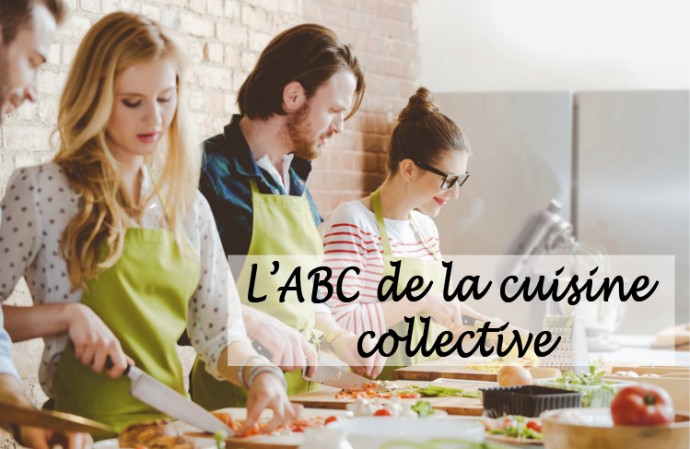These days, people are talking about collective kitchens all over the Web. Some know the movement really well. Others may be participating without even realizing it. To shed some light on it, we’ve written a whole article on the subject. Cooking in a group isn’t new. Just think about your grandparents or great grandparents who made jams with their harvests at the end of the summer. Everyone would pitch in to make it easier and each person would bring their share home. Nowadays, even if you don’t cook in a group to help out, you get a lot of pleasure out of cooking with those you love!
So what is a collective kitchen?
A collective kitchen means cooking in a group. The principle consists of preparing recipes in large quantities, then distributing them in equal parts to the participants. This is done especially in cooking communities throughout the country. Cooking in big batches is really economical and that’s why social movements were created.
How to be efficient

If you decide to cook in a group at home, you should build a solid plan of action to be efficient. Here are a few steps that will make it easier for the day you cook:
-
Planning
Planning is the most important step of every group cooking session! At this stage, you’ll have to:
- Choose your recipe(s): Take the time to consult recipe books, blogs and cooking magazines to choose the recipes you’ll make together. Adjust the number of recipes according to the time you’ll put in the activity, the number of participants (ideally between 4 and 8 people) and their level of expertise. If you and your group are just starting out, don’t make more than two simple dishes, whereas if you’re more experienced, make four or five.
- Make a list of ingredients: Once you’ve chosen your recipes, write down the ingredients you’ll need. The person in charge of getting the groceries will also find this list helpful.
- Make a list of the equipment and material needed: pots, utensils, baking sheets, etc. Plan this the day before so you won’t be caught off-guard.
- Share tasks: Assign tasks so everyone will know who’s doing what in the kitchen. This way, people get to do what they want and the experience will be much better for everyone involved.
Planning your day of cooking is the best way to avoid surprises the day of.
-
Purchases
Again, your trip to the grocery store requires proper planning. With the list already done, you just have to decide who will do the groceries. The group can go together and separate the shopping cart by making sure that everyone spends the same amount. If not, designate one person who will be reimbursed later by the group. Do whatever is best for everyone. If you want to save money, look at flyers or use a mobile app to find out what discounts are offered in different grocery stores. This way, you can save money right from the start!
-
The kitchen
 The time has finally come! You’ve prepared yourself for this day and now it’s time to have fun. Some people will be chopping, others seasoning the dishes and one will be in charge of the cooking. If everyone is at their stations, the session will be efficient and fun. What’s great about cooking in a group is that you can align everyone’s strengths and preferences to get a delicious result! Don’t forget that being a head chef isn’t a prerequisite. What counts is having fun.
The time has finally come! You’ve prepared yourself for this day and now it’s time to have fun. Some people will be chopping, others seasoning the dishes and one will be in charge of the cooking. If everyone is at their stations, the session will be efficient and fun. What’s great about cooking in a group is that you can align everyone’s strengths and preferences to get a delicious result! Don’t forget that being a head chef isn’t a prerequisite. What counts is having fun.
-
Distributing the meals
Once all the recipes have been made and taste-tested (a step that shouldn’t be neglected!), it’s time to distribute the food. If you plan on freezing it, make sure the containers are airtight. Preferably use bags, plastic wrap or containers designed specifically for freezing. To make things easier, once you get home, label the contents of the dish and the date it was prepared. This way, you’ll be able to easily tell which meal to eat before it goes bad. Separate everything equally so people can enjoy at home. At the end of the day, everyone will be happy to leave with their booty!
Don’t forget
To minimize the risk of cross contamination, there are hygiene rules you should respect when preparing the food:
- Wash your hands regularly
- Keep tools and workspaces clean
- Don’t keep food out at room temperature too long
- Keep raw meat and poultry away from other food
- Refrigerate or freeze individual portions as quickly as possible
Where to cook in your community
Every year, more than a million servings are made in 2,000 collective kitchens in Canada which helps more than 850,000 people. People often have misconceptions about these organizations, but they help everyone, not just low income or disadvantaged people. Over and above saving money, there are many advantages to cooking in a group as you’ll see below. Are you interested in cooking with a community group? To know if this type of activity exists near you, ask a nutritionist, contact a clinic or food bank in your area or visit any of these websites:
- Quebec: http://www.rccq.org/
- British Columbia: http://www.freshchoicekitchens.ca/
- Alberta: http://www.albertafoodbanks.org/kitchens
- New Brunswick: http://foodbanksnb.com/
- Newfoundland and Labrador: http://www.foodfirstnl.ca/
- Ontario: http://foodshare.net/
- Saskatchewan: http://www.chep.org/
- Manitoba: http://www.familydynamics.ca/
- Nova Scotia: http://nechc.com/
- Prince Edward Island: http://chancesfamily.ca/
- Yukon: http://www.manyrivers.yk.ca/
Sometimes, you can’t join a collective kitchen group because of conflicts between your schedule and the schedule of the centre that offers the service or the service simply doesn’t exist near you. Solution? Start your own group with your friends, family, neighbours or colleagues and cook together!
Canadians and the collective kitchen
In December, Arctic Gardens surveyed 1,750 Canadians to what they thought of cooking in a group. This is what we discovered:
Almost half of Canadians have cooked in a group
 Half of the respondents said that they’ve cooked in a group in the last year. For most of them, they did it one to six times per year, whereas a few said that they do it every month, sometimes more often.
Half of the respondents said that they’ve cooked in a group in the last year. For most of them, they did it one to six times per year, whereas a few said that they do it every month, sometimes more often.
When do we cook?
Fall and winter are the best times to cook in a group. Most of the time, we do it as a family or with friends.
What do we cook?
 Collective kitchens make jars and stews most often. That’s not surprising since they’re easy to adapt for big batches and are practical to have around. Then come snacks and desserts, sauces (especially the ever popular spaghetti sauce), and casseroles. They keep well and are ideal for meals throughout the week! Finally, people said preparing food in groups during the holidays. Meat pies, egg rolls, donuts, pâté and company are cooked in teams, then separated, so everyone brings their part of the festivities home.
Collective kitchens make jars and stews most often. That’s not surprising since they’re easy to adapt for big batches and are practical to have around. Then come snacks and desserts, sauces (especially the ever popular spaghetti sauce), and casseroles. They keep well and are ideal for meals throughout the week! Finally, people said preparing food in groups during the holidays. Meat pies, egg rolls, donuts, pâté and company are cooked in teams, then separated, so everyone brings their part of the festivities home.
Why do we cook in groups?
 For some people, cooking in a group is a tradition to prepare holiday meals or can goods at the end of the summer, for example. For others, it’s an occasion to learn or try new recipes that they wouldn’t otherwise try on their own. However, 5 reasons stand out, so here they are:
For some people, cooking in a group is a tradition to prepare holiday meals or can goods at the end of the summer, for example. For others, it’s an occasion to learn or try new recipes that they wouldn’t otherwise try on their own. However, 5 reasons stand out, so here they are:
To lighten the load of preparing meals
 First of all, Canadians practice collective cooking because it lightens the load of preparing meals. Some cook enough for a whole week. Others for a month, but they all agree that it’s easier to decide what to eat for supper when there’s a prepared meal already in the freezer.
First of all, Canadians practice collective cooking because it lightens the load of preparing meals. Some cook enough for a whole week. Others for a month, but they all agree that it’s easier to decide what to eat for supper when there’s a prepared meal already in the freezer.
To save time
 Respondents admitted that they cooked in a group because it saved them time. In fact, since meals for the week are ready, you don’t need to prepare them when you come home from work. Just reheat and serve. Not only do you save time, but you don’t have to wrack your brain on what to make!
Respondents admitted that they cooked in a group because it saved them time. In fact, since meals for the week are ready, you don’t need to prepare them when you come home from work. Just reheat and serve. Not only do you save time, but you don’t have to wrack your brain on what to make!
To have ready-to-eat meals on hand
 Without a doubt, having meals that are ready to eat in the freezer is a huge advantage of cooking in a group. Meals just have to be reheated and enjoyed! You don’t have to prepare dinners or snacks throughout the week.
Without a doubt, having meals that are ready to eat in the freezer is a huge advantage of cooking in a group. Meals just have to be reheated and enjoyed! You don’t have to prepare dinners or snacks throughout the week.
To save money
 Then survey respondents told us that cooking in a group allows them to save money. It’s true that sharing the cost of groceries lightens the bill for everyone who participates. As well, if some people in the group have a knack for saving money at the grocery store, you can benefit from their know-how to save even more.
Then survey respondents told us that cooking in a group allows them to save money. It’s true that sharing the cost of groceries lightens the bill for everyone who participates. As well, if some people in the group have a knack for saving money at the grocery store, you can benefit from their know-how to save even more.
For the fun of it
 Finally, the main reason that Canadians cook in a group is because they like what it gives them. You have to admit that preparing good meals with people you like is a real pleasure! It allows us to spend quality time with friends or family and create bonds. Let’s just say it: cooking in a group combines being practical with having fun!
Finally, the main reason that Canadians cook in a group is because they like what it gives them. You have to admit that preparing good meals with people you like is a real pleasure! It allows us to spend quality time with friends or family and create bonds. Let’s just say it: cooking in a group combines being practical with having fun!
Recipes perfect for group cooking
 It’s not always easy to find recipes for big batches. To solve this problem, here’s how you can adapt your favourite recipes for large quantities or try one of these delicious recipes that we’ve found for you:
It’s not always easy to find recipes for big batches. To solve this problem, here’s how you can adapt your favourite recipes for large quantities or try one of these delicious recipes that we’ve found for you:
Vegetable soup Mini cakes with molasses
Beef root veggie stew Spaghetti sauce
Chicken coq au vin Roasted eggplant and tomato baked orzo
Traditional sugar cookies Mac and cheese
Also visit the recipe box at the Group of Collective Kitchens of Quebec.
Whether with family, friends or an organized group, the collective kitchen is without a doubt a source of pleasure. Hesitate no more and sign up with a kitchen near you or organize your own group and reap the benefits. Why not try it?








